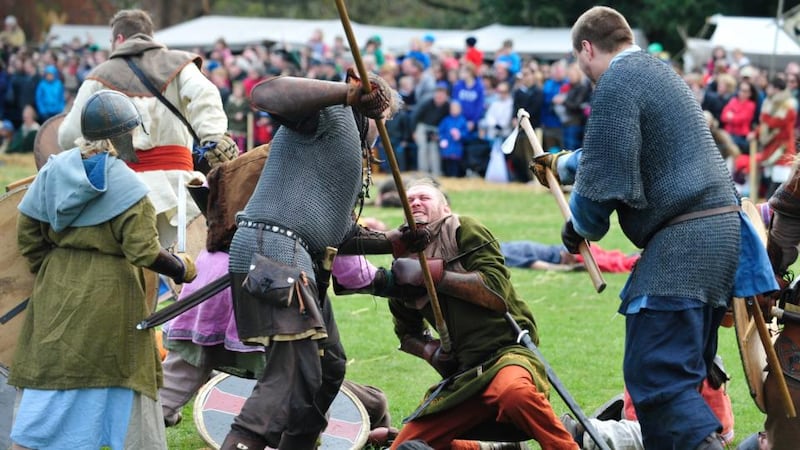Iain Barber is narrating an unfolding battle with the melodramatic enthusiasm of Mícheál Ó Muirhceartaigh. A warrior falls to his knees, "He has been sent to," he pauses dramatically, "Valhalla!" "The people on the ground are dead," a small girl behind me explains. "In real life there'd be guts and stuff."
Five hundred warriors from Ireland, Britain, Scandinavia, Germany, Russia and America are re-enacting the Battle of Clontarf in St Anne's Park amid a Viking village of tents and tradesmen. Thousands have come to the park to watch (the battle was re-enacted twice on Saturday and twice yesterday). Spears and swords rattle off shields and warriors outdo one another with dramatic death scenes. One impressively hammy swordsman staggers, clutching his stomach in Shatneresque consternation for half a minute. Children are hoisted on to parental shoulders to view it all and add to the narration.
“Ireland won? YES!” says the child behind me, punching the air at the end of the first pitched battle.

“Let the dead arise!” says Barber and the corpses jump to their feet.
“They’re zombies now,” explains the child.
This is the largest-ever re-enactment event in Ireland. As families picnic, fully costumed Vikings mint coins, sell weapons and weave clothes. There are incongruous sights. A tall, bearded warrior walks an Irish wolfhound by a woman pushing a Yorkshire terrier in a pushchair. A bespectacled little girl fires arrows at a range depicting a deer and a tiger and a rhino (did Vikings hunt rhinos?).
English Viking Paul Cronan tells me that while they aim for historical accuracy, in the rehearsal the Vikings kept nearly winning by accident. After the initial fight, he says, there'll be some "free fighting." "That's when we get to rewrite history," he says.
Neil Byrne from the Dublin Living History Society says it wouldn't really be rewriting history to say the Vikings won. "Boru won the battle, but he died and his sons died . . . while Sitric died an old man still king of Dublin. We get told Boru drove the Vikings out of Ireland but that isn't what happened at all."
Byrne says that some people get into re-enactment for the fighting, but for others it's all about crafts. His friend, Liga Gulbe, a trained archaeologist, has perfected an ancient Viking form of knitting. Byrne's wife, on the other hand, "is one of the combatants and has no interest in crafts or living history".
On the future battlefield, Trevor Roache is demonstrating feats of falconry with a Scandinavian barn owl. Using the heads of child volunteers as temporary perches he gets the bird to fly across the field to his waiting arm. Every now and then, the bird refuses and stays on a confused child's head. "As you can see, [the barn owl] likes to make me look like a complete thick," says Roache, speaking through a hands-free microphone. "Barn owls don't care about embarrassing you."
Today, St Anne's Park is filled with offbeat hobbyists. Sam Burke, a long bearded aficionado of ancient instruments, plays Viking whistles and flutes, before "more tenuously connected" instruments like the symphony, the lute and the wire-strung harp. "And that's how 13th century Italians rocked out," he says after a stirring tune on the saz.
Over at a Viking longboat, youthful Ardglass Viking Dan Clarke is jabbing a sword at an impressed-looking mother and child. "Remember," he calls after them. "Go for the eyes and throat."
His older friend Paul Kavanagh explains how the Ardglass Vikings recreated these beautiful ships and bring them from event to event, often for charity. "I focus on boats," he says. "I'm a bit old for the fighting."
Across the battlefield, Tanja Warkentin, a German woman from the Cork-based Bran Dubh re-enactment club, is doing some exquisite looking tablet weaving. Where did she learn that?
"YouTube, " she says.
Her friend Brendan Halpin is discomfiting bystanders with medieval medical instruments. Some people look green as he explains and mimes the uses of the amputation chisel, the cauterising iron and the trepanning rod. His tool selection is typical of an 8th century Arabic surgeon's kit. "If someone tells me they're too 'sanguine' I'm the man to deal with that," he says. "I'll blood-let anyone."
Norwegian Nille Glaesel explains how she spends four months a year as a “Viking gypsy” going from fair to fair making authentic Viking clothing. In September, she’s going to an event in Dubai celebrating the historical connections between Viking and Arabic traders. “What I love about the Vikings,” she says, “is their philosophy of respect for foreigners. Western culture can be individualistic and selfish now, but I’m teaching my children to take care of the clan and to be responsible and to respect new people. That’s more important than the things you own.” She smiles. It’s the Viking way.


















